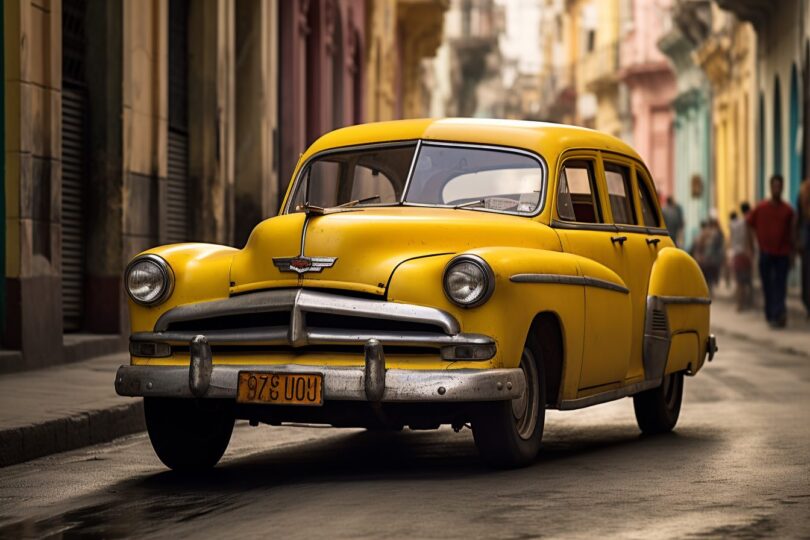Table of Contents
Once you leave the plane, the first thing you’ll worry about is how to get to your hotel. Most large hotels have a transfer service from the airport, but you have to wait long to get all the guests. Buses do not turn on the air conditioning while parked and waiting for an hour in the heat can be an unpleasant start to your journey.
Much faster and more comfortable would be to get to the hotel by car and today we will tell you how to do it safely and comfortably.
If you travel a lot, renting a taxi is not a problem for you. You know you have to walk out of the airport building, find a taxi sign, sometimes wait, and voila, you’re on your way. In Cuba, everything is about the same, but you need to know which vehicle your trip will be safe and comfortable in and which is better not to get in at all.
Today we’ll tell you all the nuances that you should know about a modern urban taxi in Cuba.
Cuban public transportation varieties
Since Cuba has been a closed country for quite a long time and remains closed to America to this day, it is very expensive for the state to update its vehicles. Therefore, Cubans are trying to make the most of what they have. Most buses have driven on Cuban roads since the 90s.
Of course, we are not talking about buses, owned by hotels. We are talking about regular buses between and inside the cities.
However since the island lives off tourists, the level of service for visitors is quite different. So two companies on the island, Viazul, and Astro offer comfortable and modern buses. Tickets for them can be ordered online on the company’s website. The whole fleet is equipped with air conditioning and what is not insignificant, the buses move according to the schedule and on certain routes.
Airplanes are much better. Cuba has several international airports: Santiago de Cuba, Havana, Holguín, Varadero, and Cayo Largo. But apart from international flights, there are also domestic ones. If you want to get to any city on the other side of the island, the most efficient option is to fly.
Since Cuba is an island washed on all sides by the ocean, it is easy to travel by ferry. It’s not cheap, but it can be interesting. If you are traveling without a reservation, it will be helpful to know that there are very convenient water connections to the Caribbean from Cuba.
In some countries, trains can be considered a romantic means of travel, but not in Cuba. This mode of transport is the least popular. Trains haven’t been updated in decades. They have no air conditioning, no reclining seats, and they don’t run on schedule.
Cubans prefer bicycles. But for us, tourists, this mode of transport is not suitable.
Urban taxi varieties in Cuba
It’s time to discuss the topic of our article, namely the modern urban taxi. In addition to getting to and from the airport, you may need transport to go to Havana, Cuba’s capital city, or to any other city close to your hotel. Well if you’re the kind of traveler who doesn’t like to spend all day sunbathing on the beach, and looking for adventure – you can’t do without a car. So cabs here fall into two categories:
· for tourists
· used by locals
Something is missing. For anyone in the U.S. or Europe, Uber is synonymous with the city cab. And here’s the not-so-good news – Uber is not in Cuba.
The main differences between one and the other are comfort, price, and safety. Old Soviet cars without air conditioning are in the parking lot. Vehicles often break down and it can happen on your way. Such services are inherently cheap but risky. Cabs for tourists are quite another matter. New cars with all the amenities and air conditioning. So let’s understand in more detail
Urban taxi in Cuba for tourists
“All the best to tourists” – this is the Cuban way of dealing with tourists and transport services. And this is how this approach manifests itself concerning auto:
· new cars
· there is air conditioning
· the route of movement is under the operator’s control
· can be ordered at every hotel
Fifteen years ago, the country’s government united all cab services into one under the name “Cubataxi”. But you will hardly find this name because all operators still use the old names: “Cubanacan” and “Turistaxi”. Only these companies’ machines can truly be called modern urban taxis in Cuba.
The company “Cubanacan” provides tourists with Mercedes cars, and “Turistaxi” specializes in Japanese cars. Cab payments are made in U.S. currency. Compared to a trip in a private non-tourist vehicle, the price can be twice as expensive. However it still does not compare to similar services in the United States or Canada. There are also two other private companies: “Transgaviota” and “Taxi OK”.
You can recognize public carriers by their blue license plates, while private carriers are equipped with yellow ones.
Private carriers
Private companies engage in local residents’ transportation, but more recently they have been allowed to work with tourists. To do so, the driver must obtain the necessary documents.
The price of a trip in a private company is lower but is it worth it? Passengers using a private cab are not insured. Despite the low accident rate, due to the small number of cars on the roads, it is a risk. One private company, “Panataxi”, operates in Havana. They mostly use old Soviet cars. Whether to use the services of such companies or not, it is up to you to decide.
What is a collective taxi in Cuba
If you see a car full of people holding things in their hands and some on the roof, it is a collective cab called “Taxi de Colectivo” or “Colectivos”. Villagers mostly use it to get to and from town. We recommend this type of transportation only for those who cannot afford to use another mode of transportation. It’s cheap but risky, and comfort is out of the question.
Because of the constant overload, these cars often break down right on the move. Reaching your destination is not always 100% likely. Sometimes it can be a minibus, but it doesn’t change that much.
What else you should know about the local taxi service
You’re bound to see yellow tricycles scurrying back and forth. That’s also a cab, CocoTaxi. It’s a kind of rickshaw cab. It is difficult to call this mode of transport comfortable and safe, but it is highly recommended to ride at least once for fun or a true Cuban flavor. It only costs $1.
But bicycle taxis are prohibited by law. Nevertheless, this kind of service is provided in Cuba. A bicycle cab will not get you very far, so authorities turn a blind eye to it.
If you don’t want to overpay, then you just need to pass for a local. To do this, when you get into the car, don’t do three things:
· don’t ask the driver how much the fare will be
· don’t ask to turn on the meter
· don’t mention your hotel as your destination – it’s obvious you’re a tourist
But if you decide to use a public cab, it’s better to call it directly from the hotel. As soon as you get in make sure that the taxi driver turns on the taximeter. And don’t hurry to order transport from your tour operator – it will cost more. But you can save if you call for a car right after landing at the “PanaTaxi” office, which you can find when leaving the airport in the Cuban capital.
How much will taxi services cost
Pricing policy influences the choice of carrier company or mode of transportation. How much Cuba costs is necessary for anyone who wants to travel to this island, which is unique in every way.
First of all, you should know how far from each other are the key population centers. For example, from the state capital to Santiago de Cuba – 860 km, but to Matanzas – 96 km. This information is useful to have an idea of how much an urban taxi costs from Havana to Varadero, which, by the way, is separated by 140 km. So, how much will the trip cost:
Booked a car through the state cab service for $6-8
Whole-day rides in a government company car are $80-100
Journey to Havana airport by private car $15-20
Private car ride in Zhiguli $0.02 per 1 km
Cyclotaxi $1 (to your destination)
Havana – Varadero $100
Cruise in a vintage car for $25 per 1 hour
Minibus for the whole day $250
The charge for catching a car on the street is $1-3 (anywhere in the city without a meter).
In conclusion
On the one hand, a vacation in Cuba’s luxury resorts is safe, but once you get into town, you may be in for a lot of trouble. Don’t skimp on your safety. The most convenient way to get around Cuba is by public cab.
It is best to book transport directly from the hotel. In this case, you are guaranteed safety and comfort.
If you have a news tip, correction or comment, let us know at: [email protected]







